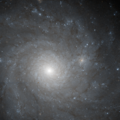| NGC 4571 | |
|---|---|
 NGC 4571 imaged by the Hubble Space Telescope | |
| Observation data (J2000 epoch) | |
| Constellation | Coma Berenices |
| Right ascension | 12h 36m 56.3959s [1] |
| Declination | +14° 13′ 02.627″ [1] |
| Redshift | 0.001107±0.0000118 [1] |
| Heliocentric radial velocity | 332±4 km/s [1] |
| Distance | 52.59 ± 1.66 Mly (16.124 ± 0.508 Mpc) [1] |
| Apparent magnitude (V) | 11.8 [1] |
| Characteristics | |
| Type | SA(r)d [1] |
| Size | ~71,600 ly (21.96 kpc) (estimated) [1] |
| Apparent size (V) | 3.6′ × 3.2′ [1] |
| Other designations | |
| VCC 1696, IRAS 12344+1429, IC 3588, UGC 7788, MCG +02-32-156, PGC 42100, CGCG 070-194 [1] | |
NGC 4571 is a spiral galaxy located in the constellation of Coma Berenices. It was discovered by German-British astronomer William Herschel on 14 January 1787. [2] It was also observed by German astronomer Friedrich Schwassmann on 23 November 1900, causing it to be listed in the Index Catalogue as IC 3588. [2] John Dreyer thought this galaxy might be the "lost" Messier 91, but in 1969, amateur astronomer William C. Williams realized that M91 was actually NGC 4548. [3]


